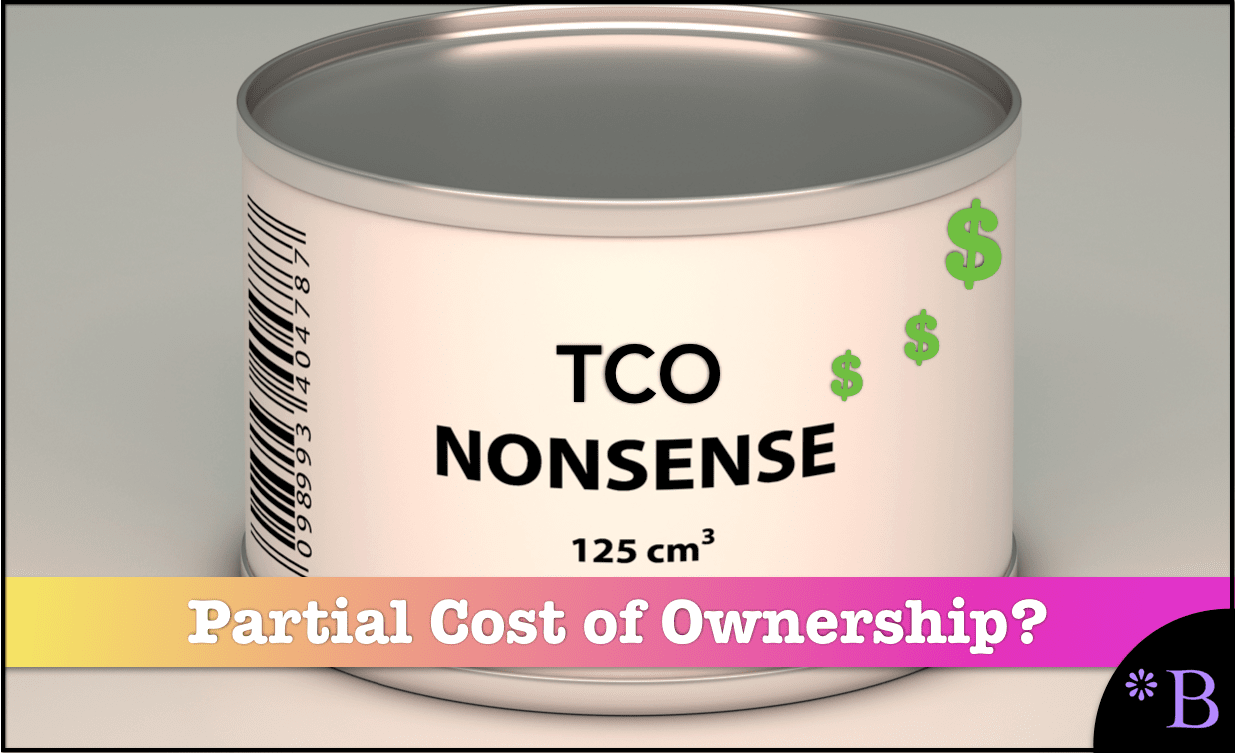Partial Cost of Ownership Calculation: How Financial Bias Commonly Undermines Software TCO Calculations that are Usable
Executive Summary
- The total cost of ownership, or TCO, for software is critical to estimating the ROI of a technology purchase.
- The problem is often who performs these TCO calculations.

Introduction
When it comes to enterprise software selection, calculating the total cost of ownership, or TCO, is critical for evaluating different products and estimating the ROI for a purchase. Unfortunately, companies looking at migrating to new software often accept promotional figures for TCO provided by technology vendors or consultants who have partnership relationships with them.
PCOs or Partial Cost of Ownership
Vendors normally publish “partial” TCOs.
An accurate estimate of the TCO for software should include both direct and indirect costs associated with the product’s use. Despite this, many software vendors will leave critical indirect costs to make their TCO appear lower in advertising materials. At Brightwork Research & Analysis, we often call this figure the “PCO,” or Partial Cost of Ownership, because critical variables, like post-go-live functionality improvements, are often left out.
When evaluating a software vendor, ask the sales consultant for a breakdown of what costs are included in the TCO. Estimates should go beyond the upfront software cost, user licenses, and maintenance and include implementation and training costs. Software vendors providing TCO estimates that don’t account for functionality improvements after post-go-live are probably being too rosy in their calculations.
Vendors and Sales Consultants Encourage Underestimating TCO and Producing Deliberately Misleading Calculations
Along the same lines, software vendors often encourage partner consultants to use formulas or information that leads companies to underestimate the TCO.
SAP’s Fake TCO Estimation
Take SAP’s HANA software, for example. The software is sold on a per Gigabyte (GB) basis, meaning it’s priced based on the size of a business’s database. As covered in our article, How To Understand Pricing of S/4HANA and HANA, the information SAP provides for determining database size often leads firms to underestimate the number of GBs they’ll need initially. Companies that purchase HANA often go over initial budget estimates when they are forced to buy more GBs of HANA after implementation.
The strategy behind this is, again, to make the TCO look significantly rosier than reality. Unfortunately, blowing estimates for the TCO hurts company profit margins and jeopardizes resource allocation in other critical business aspects.
Custom TCO calculations Often Leave out Critical Variables
Critical Variable #1: Not Acknowledging Knowledge Gaps
Businesses that decide to go beyond vendor-provided figures and calculate the TCO of the software in-house will often leave out critical variables or expenses. Or, they may not have enough knowledge of the software to predict the surprise above costs.
Critical Variable #2: Missing Cost Components
When calculating the TCO, businesses should sum up the costs associated with the software and user licenses, hardware for on-premise products, implementation, maintenance, and lifetime improvements like new functionality, and not leave out cost components. However, it is most common to complete miss very significant cost categories.
Critical Variable #3: Other Gaps
Additional variables that should be considered include the cost of data migration, initial training and future training for new employees, potential downtime costs, upgrades for on-premise software, and application security.
Conclusion
With so many variables to consider, it makes sense to start with an online TCO calculator for a ballpark figure and then bring in an expert to fine-tune your estimate.
- Brightwork has independently developed TCO calculators for over 50 of the most famous enterprise software applications. These calculators, which only require essential inputs, are free to use. Each calculator has been thoroughly tested and validated by companies implementing the software.
- Our calculators incorporate average business costs for variables such as implementation. Still, every company will have different expenses depending on external costs and the number of internal resources applied to new software migration.
- These experts can also help you analyze the less tangible benefits, such as cost savings your organization can achieve from increased productivity and efficiency with new software.
- When faced with a decision on where to invest millions of dollars over a 7-to-10 year time span, there is a clear ROI for outside expertise that helps a company overcome the challenges of determining TCO and purchase the right software.